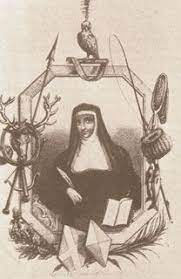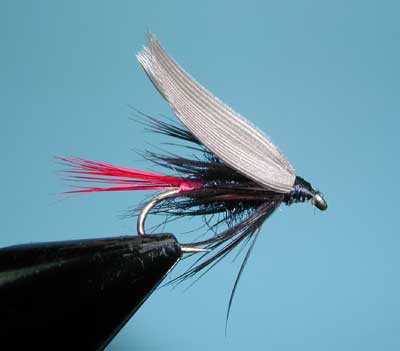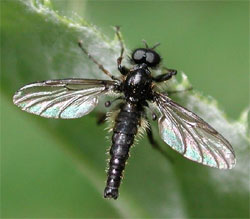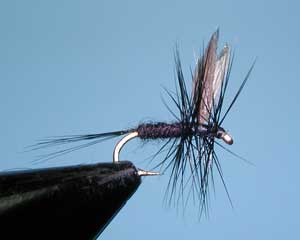Notes:  The Black Gnat is a traditional Classic Fly dating back to the times of Dame Juliana Berners in 1496. From her book, A Treatyse of Fysshynge wyth an Angle (1496), the earliest known volume on sport fishing, Dame Berners described the use of Quill wings for creating wet flies that mimic the natural insects she studied. Berners was a noblewoman and prioress of the Sopwell Nunnery near St. Albans, Eng., during the late 15th century, but little is known or recorded about her life other than her writing and publication of the Treatyse. Many people credit her with the entirety of The Boke of Saint Albans which was printed in 1486 by an unknown schoolmaster at St Albans. It has no title-page. The only clue to the authorship of the Treatise, and the only documentary evidence of her, is an attribution at the end of the original 1486 book that reads: "Explicit Dam Julyans Barnes in her boke of huntyng." Her name was changed by Wynkyn de Worde to "Dame Julyans Bernes".The Black Gnat is typically tied using a Natural Gray Duck Quill wing. It is in a class of Wet Flies that include the Royal Coachman, Coachman, and Leadwing Coachman, utilizing the Natural Quill wing. The Black Gnat is a traditional Classic Fly dating back to the times of Dame Juliana Berners in 1496. From her book, A Treatyse of Fysshynge wyth an Angle (1496), the earliest known volume on sport fishing, Dame Berners described the use of Quill wings for creating wet flies that mimic the natural insects she studied. Berners was a noblewoman and prioress of the Sopwell Nunnery near St. Albans, Eng., during the late 15th century, but little is known or recorded about her life other than her writing and publication of the Treatyse. Many people credit her with the entirety of The Boke of Saint Albans which was printed in 1486 by an unknown schoolmaster at St Albans. It has no title-page. The only clue to the authorship of the Treatise, and the only documentary evidence of her, is an attribution at the end of the original 1486 book that reads: "Explicit Dam Julyans Barnes in her boke of huntyng." Her name was changed by Wynkyn de Worde to "Dame Julyans Bernes".The Black Gnat is typically tied using a Natural Gray Duck Quill wing. It is in a class of Wet Flies that include the Royal Coachman, Coachman, and Leadwing Coachman, utilizing the Natural Quill wing.
Frederick Michael Halford was the first to adapt this pattern to a dry fly in 1885. His pattern was a thin body of a black chaffinch tail feather that was stripped. This created a body that was light, glossy, and non-absorbant. He used matched slips of a pale starling wing quill for the wings set in a downward profile. In front of the wing he hackled with a cock starling. He noted that the female gnats had longer wings than the males and tied two versions accordingly. Halford primariily fish the river Test and studied the aquatic insects of the river. He became obsessed with dry fly presentations rather than wet fly and suggested that if the North Country was identified by wet flies, the South Country with it's chalk stream should be the home of dry flies. Over the next 20 years, Halford's dogmatic views of dry fly fishing brought on "dry fly only" waters thoughout much of the South Country and were adapted within the Catskill region of New York by Theordore Gordon.
Gnats tend to be prolific near stillwaters, particularly around the reedbeds. They will rise in clouds above the reeds and will be blown into the water by wind.
They are a member of the Fly family and lay their eggs within running water. The gnat larvae remain within the water for about ten days clinging to rocks before emerging. They are known for biting and can be called midges or no-see-ums.
|




